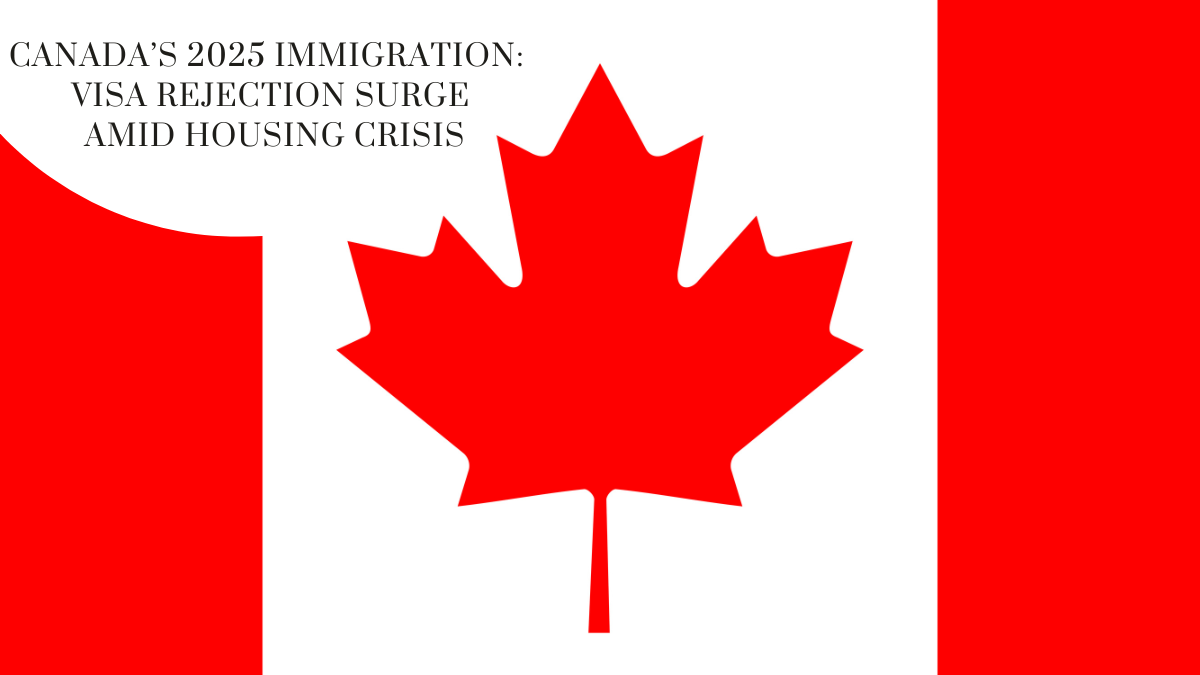1. 📉 Record High Visa Rejections in 2024
Canada saw a sharp rise in temporary resident visa rejections, jumping from around 35% in 2023 to approximately 50% in 2024. In total, over 2.36 million applications—including visitor, study, and work permits—were refused .
- Visitor visa refusals climbed sharply, reaching 54%, with around 1.95 million out of 3.6 million applications denied.
- Study permit refusals were also high—approximately 52% of applications were refused amid tighter-financial requirements.
- Work permit refusals remained lower, at about 22%, reflecting more selective targeting of labour needs .

2. 🏠 Why the Shift? Tackling Housing & Resource Strain
These stricter immigration policies are in response to growing concerns about housing affordability, overburdened infrastructure, and public services .
- Government-commissioned analyses warned that immigration-driven population growth outpaced housing supply .
- Provinces like Ontario need over 1.5 million new homes by 2031, but labour shortages—including skilled trades—hinder progress.
- To ease affordability, Canada plans to reduce permanent resident admissions from 485,000 in 2024 to 395,000 in 2025, then to 380,000 in 2026 .
- Additionally, the number of temporary residents will drop from 330,000 to around 300,000 in 2025 .
3. 🛂 Policy Measures & New Minima
In 2025, Canada introduced several immigration policy adjustments aimed at reducing temporary inflows and refining eligibility :
- Tighter work-permit and study-permit requirements, with stricter financial evidence and intent-to-return criteria.
- Global public ad campaign warning asylum-seekers of the difficulty of successful claims .
- Post-graduate work permit limits and streamlined visa eligibility reviews; thousands of asylum cases are being fast-tracked or denied .
- Fraud detection intensified, with up to 9,000 fraud investigations monthly, leading to visa bans for repeat offenders .
4. 🏗️ Housing Crisis & Skilled Worker Pathways
Tight immigration has been linked to pressures on the housing market and skilled labour shortages:
- The Housing Accelerator Fund aims to fast-track 750,000 new homes over ten years.
- Yet, construction is being hampered by labour deficits, prompting new pathways for foreign apprentices and undocumented construction workers canada.ca.
- A Tripartite Advisory Council will coordinate efforts to ensure adequate skilled trades availability canada.ca+1immigration.ca+1.
5. 🧭 What It Means for Applicants
If you’re applying for a Canada visa in 2025, be prepared:
- Stricter financial evidence: Demonstrate the ability to support yourself and your dependents.
- Tighter study plans: Your academic purpose and intent to return must be convincing .
- Shorter processing times and less flexibility in appeals for asylum cases .
- Focus on economic and labour alignment: Skilled trades, apprenticeships, and construction roles are prioritized .
6. ⚖️ Balancing Risks and Opportunities
| Sector | Impact of Policy Changes |
|---|---|
| International Students | Study scholarships face higher barriers; revenues may decline . |
| Employers | Labour shortages in key sectors may persist despite new pathways . |
| Housing Market | Lower immigration may ease prices but risks construction capacity . |
| Genuine Aspirants | More scrutiny on visa applicants; fraud detection intensifies . |
✅ Final Takeaway
In 2025, Canada’s immigration system is undergoing a pivotal transformation:
- Visa refusal rates for temporary visas remain near record highs (≈50%).
- Immigration targets have been reduced significantly to alleviate housing and infrastructure pressure.
- Policy focus has shifted to economic alignment and stronger fraud detection.
- Future visa applicants must prepare robust applications: clear finances, study/work intentions, and plan B if refused.
While these changes seek to stabilize housing and public services, they also raise questions about Canada’s economic resilience, global talent pipeline, and social dynamics. Staying well-informed and compliant is more crucial than ever for anyone seeking to make Canada their home or workplace in 2025.











